
These top 10 cake hacks will make baking and decorating cakes easier, they’ll save you time, AND you’ll learn some techniques to create stunning cake designs. If you prefer to watch a video of this tutorial, scroll to the bottom of the page.
1. Bake efficiently
To be super efficient, bake cakes in batches even if you’re not going to decorate or serve some of these cakes for the next month. By following this hack and baking in bulk, you’re maximizing the time you spend taking out ingredients, preparing cake batters and pans and washing everything afterwards.

Let the cakes cool completely and then for any layers you aren’t going to need straight away, wrap them in two layers cling film or Saran Wrap and freeze them until you’re ready to use them. The plastic wrap will prevent them from drying out and they’ll be just as moist and delicious when you defrost them up to a month later!

2. Make easy mini or shaped cakes
To make mini cakes or shaped cakes, if you don’t have the right size or shape cake pan, bake a sheet cake or use whatever pan you have.

After the cake cools, use a cookie cutter to cut our your cake layers. You can do this with round cookie cutters or any shape you like, like these little heart cake layers.

It’s easiest to cut the shapes out when the cake is cold because then it’s less crumbly, so I chill my cakes in the fridge for 30 minutes to an hour before doing this.

Assemble your mini cake by alternating these layers with the filling of your choice and you’ll probably find it easier to pipe on your filling using a piping bag, instead of spreading it on, since the cakes is so small and lightweight.

Attach your cake to a cake board using a dollop of frosting to secure it and then frost and decorate!

3. Get smooth frosting
The hack for super smooth frosting is to control the temperature of your cake. Chill your cake layers in the fridge before assembling your cake so that they firm up and don’t crumble. Then pipe or spread a dot of buttercream onto the cake board to attach your first layer of cake to the cake board.

As you assemble your cake, you’ll find that the cake layers are easier to move around when they’re cold than when they’re at room temperature. You’ll even be able to adjust them after placing them on top of a layer of filling, so you’ll be able to assemble a straight cake that doesn’t lean to one side.

After assembling your cake, put it back in the fridge to chill the cake again for 30 minutes AND to chill that dot of buttercream, which will set and secure the cake in place. Cover your cake in a crumb coat, which is a very thin layer of frosting that catches any crumbs that come off the cake as you frost it. Having a cold cake will make the layers much sturdier, so it won’t wobble around.

Chill the cake for another 30 minutes in the fridge to set the crumb coat so that any crumbs get trapped in that layer of frosting. Now your final coat of frosting won’t have any crumbs in it. Frosting your cake when it’s cold means you can spread on your frosting easily, and apply as much pressure as you need to with your frosting smoother without worrying about knocking the cake over.

4. Make homemade stencil designs
For very easy but stunning stencil designs, draw a shape onto parchment paper or trace over a picture or around a cookie cutter. Cut out the shape, keeping the outline intact and that will be your stencil.

Wrap the stencil around a cake that’s been chilled in the fridge for an hour so that the frosting is cold and firm and then spread more frosting over the stencil. This is one of the 50 techniques I teach in my online course on 50 Easy Cake Decorating Techniques for ANY Skill Level.

Spreading from the outside of the shape towards the middle makes the neatest shape because this way, you won’t accidentally push any frosting underneath the stencil to smudge the outline of the shape. Smooth the frosting and then peel off the parchment paper to reveal a neat shape on your cake!
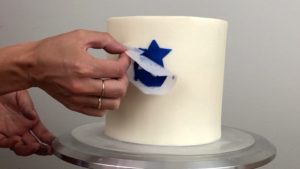
Another way to use these homemade parchment paper stencils is to press sprinkles into the frosting you spread over the stencil and when you peel the parchment off, you’ll leave a gorgeous sprinkled design behind on the cake!
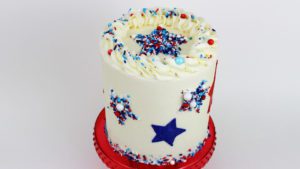
5. Create detailed designs you can’t freehand
To create intricately detailed designs you can’t freehand, especially onto the upright sides of a cake, draw or print an image and tape parchment paper on top.

Put buttercream in piping bags fitted with small round tips like a #2 or #3. If you don’t have any small round piping tips, cut a small bit off the end of a new piping bag to make a small hole. Pipe the details onto your design one colour at a time, chilling the design in the fridge for 15 minutes before moving onto the next colour.

You can tape the parchment and printed image onto a tray to make lifting it up easier. Use your final colour of frosting to fill in the background colour of the design, like the yellow body of this giraffe.

Spread this last colour of frosting over the rest of the design to make it flat and also sticky, since the previously piped details will be hard from chilling them. Lift the parchment up immediately, before the frosting sets.

Press the parchment paper against the side of a frosted cake. frosting on the cake needs to have set before doing this. The piped design should be in between the parchment paper and the cake, so that it can attach to the frosted cake.

Put the cake with the parchment still pressed against it back into the fridge and after an hour, when everything is cold and firm, take the cake out and peel off the parchment to reveal your detailed design, which will be perfectly flat and smooth!

6. Frost cakes with wrapping paper
Take this a step further by covering an entire cake in an intricate design like wrapping paper or a gift bag! Cut a piece of acetate or parchment paper so it’s as tall as the cake and a few inches longer, so you can wrap it around the cake with some room to spare.
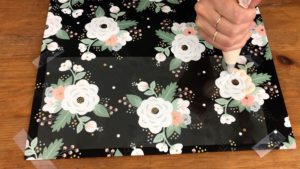
Tape the acetate over your wrapping paper or whatever design you want to use and if the acetate curves because it’s from a roll, place it so that the ends are curving upwards, which is important for later. Trace your design using piping bags just like in the previous hack, chilling the details before spreading your final colour of frosting all over the acetate, right up to the edges.

Lift the parchment up and wrap it around a cake with a crumb coat. Piping the design on the inner part of the curve means the acetate or parchment will wrap itself easily around the cake.

The frosting on the acetate will stick to the frosting on the cake. Press it with your hand or a fondant smoother so that it lies flat against the cake and put the cake in the fridge for an hour before peeling the acetate off.

Use a sharp knife to trim any frosting sticking up over the top edge of the cake. You can tidy up the frosting with a frosting smoother and add any details you like, like piped borders or some shading with more frosting, or sprinkles!

7. Create fondant designs with buttercream!
Avoid fondant and stencils by adding simple colourful shapes to the sides of your cake with buttercream that looks just like fondant! Tape parchment onto a tray or cutting board and spread buttercream thinly onto it, getting it as smooth as you can. Place the board in the freezer for 10 minutes and then use cookie cutters to cut out shapes.

Lift the frozen buttercream shapes up with an

To curve the shapes around the cake, wrap parchment paper around them and leave them for a few minutes to thaw before pressing them gently. The parchment paper will prevent any stickiness and texture from your fingers. Put the cake in the fridge or freezer for a few minutes to set the buttercream shapes and then peel the parchment paper off. This achieves the effect of fondant with the taste of buttercream!

8. Frost square cakes without tools
Square cakes can be really time consuming and tricky to frost but with this simple hack you can frost square cakes quickly and neatly, with super sharp edges and corners, with no special tools! All you need is a cardboard box. Measure your cake layers and cut out three squares from your cardboard box: 1 that’s the same size as your cake layers and 2 that are 2cm or 3/4 of an inch bigger than your cake layers.

Wrap the cardboard in parchment paper so it’s clean and pull it tightly before you tape it down, so the edges are very smooth.
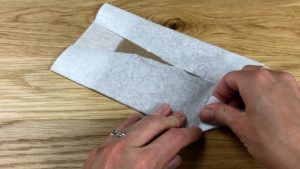
Assemble your cake on the smaller square and then cover the cake with a crumb coat, placing it on a larger cake board to catch any smudges of frosting.

Assemble your cake on the smaller square and then cover the cake with a crumb coat, placing it on a larger cake board to catch any smudges of frosting.

Now place a non-slip mat or tape on a cake board, put one of your large squares on top, and then tape your cake on the small square onto it.

Spread frosting thickly on top of the cake and place the other large square on top, lining it up with the large square at the bottom, and push down firmly to flatten the frosting on top of the cake.

Spread frosting around the sides of the cake and as you scrape with your frosting smoother, the cardboard with keep the sides straight!

Spread from one edge towards the middle, and then from the other edge back towards the middle in the opposite direction, to keep the corners sharp.
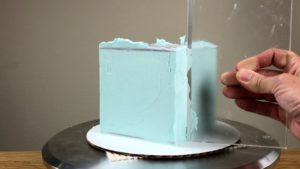
Chill the cake for an hour to set the frosting and then use a sharp knife to cut off the square on top of the cake.

9. Quick cake toppers
For quick cake toppers of any shape, draw your shape or number and place a piece of parchment paper on top of it. Spoon melted chocolate into a ziplock bag and cut a piece off one corner and then trace the shape, filling it in with the chocolate, too.
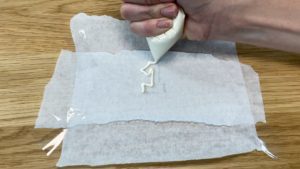
Press a toothpick into the shape, going half way up, or flatten the top part of a paper straw and push that in. This will secure the cake topper into a cake eventually.

Pipe more chocolate over the top to cover it and to make the shape thicker and stronger. You can use a toothpick to smooth the chocolate.
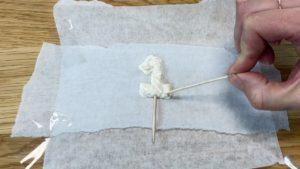
Then pour sprinkles on top, pressing them gently into the chocolate. When the chocolate sets, lift the shape up and push it into your cake!

10. Write on cakes
To write on cakes with beautiful letters even if you have shaky hands and ugly handwriting, like I do, outline capital letters in the frosting on your cake and then use a piping bag fitted with a small round tip like a #2 or #3 tip to pipe tiny dots along the letters you outlined to form neat, easy, letters!

For more cake ideas and inspiration, join my Club for access to ALL of the classes on my online cake school, both current and future classes, as well as exclusive members-only live demonstrations and Q&A sessions!

Here’s the video version of this tutorial:
